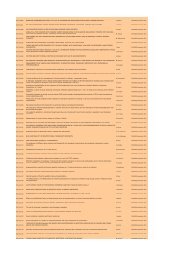Profilaksa DVT kod velikih ortopedskih operacija - Depol ...
Profilaksa DVT kod velikih ortopedskih operacija - Depol ...
Profilaksa DVT kod velikih ortopedskih operacija - Depol ...
Create successful ePaper yourself
Turn your PDF publications into a flip-book with our unique Google optimized e-Paper software.
20 - 22 September 2012, Opatija, Croatia<br />
THE IMMUNOPATHOGENESIS OF RHEUMATOID ARTHRITIS<br />
Asja Stipić Marković, Department of Clinical Immunology, Pulmology and Rheumatology, Clinic for Internal<br />
Medicine, Medical School University of Zagreb, University Hospital Sveti Duh, Zagreb, Croatia<br />
Rheumatoid arthritis (RA) is an autoimmune disease in which the synovial tissue transforms into a destructive pannus<br />
leading to erosions and lost of joint functions.Why the systemic loss of immune tolerance is linked to a localized onset<br />
of inflammation in the joint is still unclear. Distinct disease mechanisms are at play in RA pathology. The heterogeneity<br />
is consequence of the multifactorial nature of the disease and specific combination of environmental factors with polygenetic<br />
background. Environmental factors have a major role in developing RA as it is shown in genetically identical<br />
twins.<br />
Factors that facilitate autoimmunity<br />
Proliferation of synovial, oligoclonal, antigen-specific, autoreactive CD4+T cells is key event in RA pathogenesis. Etiological<br />
antigens are selfproteins, formed, for example, after alterations in citrullination of mucosal proteins upon influence<br />
of environmental stressors on barrier tissues (ie, smoking on pulmonary tissue). Several citrullinated self-proteins with<br />
neoepitopes are recognized, but most of the patients with seropositive RA have antibodies for citrullinated α-enolase<br />
(anticyclic citrullinated peptide antibodies).That is accompanied with strong association with smoking and common<br />
aminoacid motif (QKRAA) in HLA-DRB1*04,PTPN22 genotype. Other citrullinated self-proteins are: keratin, fibrinogen,<br />
collagen, vimetin and fibronectin, all showing similar interactions with smoking and same risk alleles. Altered citrullination<br />
of mucosal proteins also could be induced in periodontal disease by bacteria Porphyromonas gingivalis, microorganism<br />
expressing PADI4 (peptidyl arginine deiminase type IV).<br />
Other important causes facilitating autoimmunity in articular compartment are various microorganisms (bacteria, viruses)<br />
and their products.They induce specific T response which crossreact with human antigens (mechanism named<br />
molecular mimicry). Another mechanism in RA pathophysiology is autoantibody production against Fc portion of human<br />
immunoglobulin, in the course of infection in which immune complexes are produced.<br />
Furthermore, an new mechanism in autoantibody-positive RA is mediated by gastrointestinal microbiome.<br />
Perpetuation of synovial inflammation<br />
Specific,autoreactive CD4+Th-1 cells, which infiltrate synovial tissue, migrate from lymph nodes where they got information<br />
about autoantigen from dendritic cells (DC). However, specific antigen induce proliferation of other T cell subsets:<br />
Th-17 (producing IL-17A,IL-17F,TNF-α) and T regulatory cells (Tregs), Foxp3 positive (important arm of the immune<br />
system responsible for suppression of the response). DCs, another key players in immune response, are patrolling and<br />
scanning peripheral tissue. They take antigens and transfer it through lymphatic system to local lymph nodes. In the<br />
lymph nodes, DCs present antigen to naive T cells and act somehow altering the morphology of subcapsular sinus floor<br />
what divert the homing route of T lymphocites, which trafficking through<br />
efferent lymph vessel infiltrate synovial membrane. In synovium, there is no balance (T cell homeostasis) between<br />
Th-17 and T regs, because macrophages and DC provide a milieu supporting Th-17 differentiation. Parallely, Tregs are<br />
blocked. Cytokines, macrophage-derived (TGF-β,IL-1β,IL-6,IL-21,IL-23,TNF-α), DC-derived (TGF-β,IL-12,IL-15,IL-18,IL-23,),<br />
Th-17 derived (IL-17A, IL-17F,IL-21,IL-22,TNF-α), and IFN-γ, create hierarchy with TNF-α at its peak. TNF-α is essential for<br />
persistence of the joint inflammation. Exclusive cytokine expression patterns are characteristic for distinct autoimmune<br />
disease. IFNs, early mediators of the innate immune response, affect initiation and amplification of autoimmunity in<br />
SLE. However, in a subgroup of patients with RA, IFN type I molecular signature is upregulated, but it could mean that<br />
this cytokine profile is patient-specific rather than a disease-specific phenomenon. Further characteristic of this subgroup<br />
of patients is increased activitiy of complement and coagulation cascades. IFN/STAT-1 activation in RA synovium<br />
could be an attempt to limit inflammation. Upregulation of IFN-induced genes has been observed in peripheral blood<br />
cells of patients with other auatoimmune disease as a common hallmark in chronic autoimmunity. Besides T cells, the<br />
synovium in rheumatoid arthritis contains B cells, plasma cells, plasmablasts, macrophages and plasmacytoid dendritic<br />
cells. B cells, localized in T-cell-B-cell aggregates, form humoral part of adaptive autoimmunity.A pathogenic role of B<br />
cells is confirmed by the efficacy of rituximab. The autoantibody level is variably altered after rituximab therapy which,<br />
with the fact that plasma cells are not targeted, suggests that these cells are not only antibody producers but have role<br />
in autoantigen presentation and cytokine production. Plasmacytoid DCs in synovium continue presentation and T cells<br />
activation. Macrophages,(M1 phenotype), represent innate immunity arm along with mast cells (produce vasoactive<br />
37




